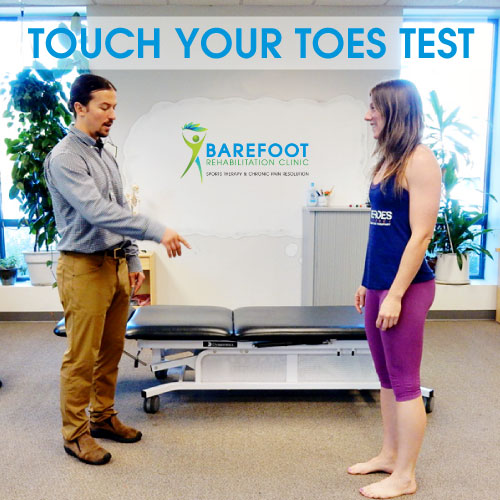
14 Dec Know Your Numbers: Standards for Musculoskeletal Health, The Low Back, And The Touch Your Toes Test
Can chronic pain be prevented if at as early an age as possible, people were aware of the inherent risk in all of their musculoskeletal parts?
Can chronic pain be fixed with understanding of musculoskeletal health standards (like the ability to touch your toes), the lifestyle choices, and subsequent pathophysiology that cause fails?
~Barefoot Rehab’s Burning Questions
When you get your blood tested and your triglycerides are high, you’re at risk for heart disease.
When you get a tissue biopsy and your cells are rapidly growing, you may be at risk for cancer.
How do you know when you’re at risk for being in musculoskeletal pain?
How do you know when you’re gambling with your fitness and that chronic pain is on the horizon? (Please comment below with any thoughts.)
I already told you how I don’t care about the diagnosis of your “herniated disc” because it’s only one part (#4 below) of the diagnosis and pain puzzle.
To have a complete diagnosis, you need:
- A full, comprehensive HISTORY with extrapolation of all important details regarding your musculoskeletal health.
- A movement EXAM by a skilled diagnostician of all relevant pieces.
- To experiment with the real-time results-based method of TEST-TREAT-RETEST to determine movement quality (with relation to holistic muscle health and the possibility of pathology).
- Diagnostic IMAGING to determine what’s going on “underneath the hood” and determine the severity of pathologies like herniated discs, which I don’t care about, on their own.
Here, we will begin to dive into the depths of what a low back movement exam (#2 above) looks like.
On the Barefoot Rehab blog, we will begin to outline standards for musculoskeletal health that tell you:
- Why you are currently in pain.
- If you’re not currently in pain, how much risk you have for potential injury and pain.
All human beings should be able to reach certain standards as an expression of fitness and health, starting with two attributes of movement.
- Mobility*: Your tissue/joints are mobile enough to reach a certain range of motion.
- Strength: Your tissue/joints are strong enough to load the correct structures of the mechanical system.
*Lexicon Differentiation between Mobility & Flexibility: Mobility is defined as flexibility with load in the real-life environment of being on Planet Earth with gravity weighing down on us. Flexibility is defined as range of motion without load.
Before one pursues increasing strength in any tissue, it is paramount that mobility be achieved first in relevant joints and tissue (as seen in the ‘ol House of Fitness Metaphor).
Disclaimer: While we are doctors at Barefoot Rehab, we cannot condone you doing these tests on your own without doctor supervision. A test, by definition, is putting load on your body, which has inherent risk attached depending on the magnitude of the load. Test and perform at your own risk.
A Word of Caution: Some Of You Can’t Be Helped
On occasion, I’ve been known to tell CrossFit coaches and owners of CrossFit boxes that some of their athletes should never do certain movements. I’ve told a 40-year-old male CrossFit athlete that he should never overhead squat due to the extent of structural damage in his shoulder, only to have him cry in front of me and never come back to get treated again.
On this blog, I will never say that I can help everyone. I understand I’m removing hope, but I hope to deliver truth in reality.
If mobilizing, doctors, practitioners, voodoo magic and anything in between were able to reduce the dysfunction and symptoms of 100% of the suffering we see, we’d be world famous by now. And there wouldn’t be 25 million people in the U.S. suffering from chronic pain (National Center for Complementary and Integrative Health).
Unfortunately, some people won’t be able to be helped. When a health professionals says they can fix you, guaranteed, 100% of the time, you should question their sanity or ability to sell.
The reality of your current health and fitness is that you’ve lived your life up to this point. You’ve either lived congruently with Mother Nature’s Rules and have been able to live the life and play the games you want. Or you have broken Mother Nature’s Rules and have been punished (with restricted ranges and many bouts of pain) because of it.
No matter where you are on life’s path, now’s the time to treat your body with respect and get a baseline for where your body is at on the fitness path.
Our intention with these tests is awareness.
As Rita Wilson said, Awareness is empowering.
Once we know where we are on the path towards our goals and dreams, we can determine which direction we want to go and start taking action to get there.
Mobility: Touch Your Toes Test | Standing Lumbopelvic Flexion (SLPF)
The ability to touch the ground with your knees straight is something that anyone should be able to do. The “Touch Your Toes Test”, or in mechanical terms, Standing Lumbopelvic Flexion, will let us know if you have that ability.
What is Touching Your Toes assessing? The mobility of your low back, hip, knee, and posterior leg integrity. These structures include bone, ligaments, tendons, cartilage, and muscles.
What Specific Dysfunctions are relevant here? Disc (derangements, bulges, herniations, sequestions, extrusions, etc.) and spine dysfunctions (stenosis, arthritis, etc.) and sciatic nerve entrapments.
What You Need to Know: A stretching sensation in your calves is not a “calf muscle” stretching. It is a nerve pulling, either from a peripheral sciatic nerve entrapment or from disc/spinal pathology in your low back.
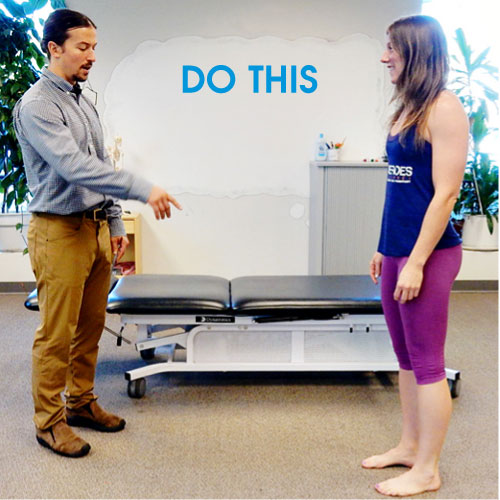
Pass:
A pass for this test is the ability to touch your toes with your knees straight. Notice, Katie has better than passing range of motion as her second knuckles on her fingers are touching the ground.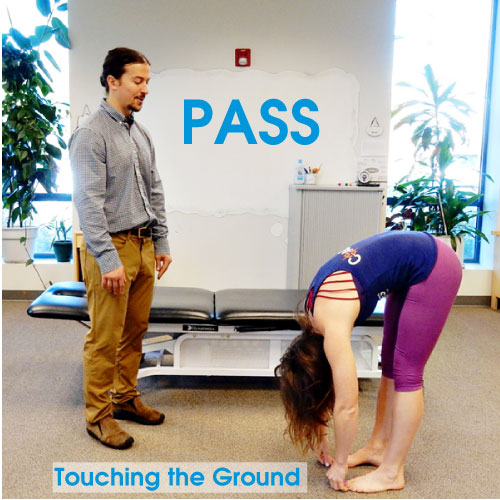
- Range: Touch the ground.
- Effort: Fast and easy.
- Symptoms: The preferred symptom is a stretch from the butt cheek to behind the knee equal in subjective tension from left to right sides.
Fail – Low Risk:
A fail is any range of motion where the fingertips are not touching the ground.
- Range: Anything between 0 – 3″ from the ground.
- Effort: Fast and easy.
- Symptoms: Tension in the low back is indicative of structural dysfunction, adhesion, or inflammation. Tension in a pinpoint spot is indicative of local adhesion. Tension in one calf is indicative of sciatic nerve entrapment somewhere between the spine and the calf on that side. Tension in both calves is indicative of significant sciatic nerve entrapment or more commonly, a space occupying lesion in the spine.
Fail – High Risk:
A fail, with an individual having no business doing high load lumbar spine movements, is anything greater than 3″ from the ground.
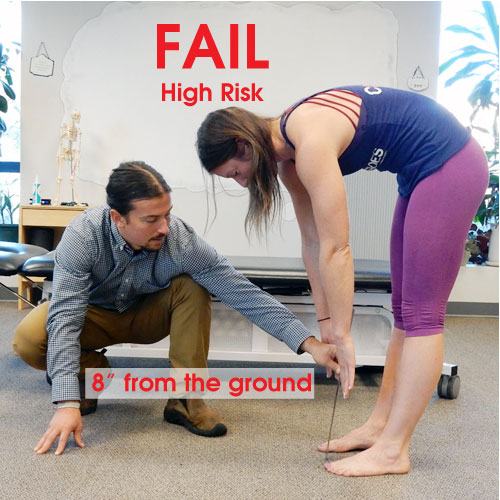
- Range: Anything more than 3″ from the ground.
- Effort: Slow and cautious, indicative of “protective tension” and “red-lighting” from the central nervous system. This protective mechanism occurs when tissue is damaged and the body is subconsciously protecting further load from occurring to the damaged tissue.
- Symptoms: Tension in the low back is indicative of structural dysfunction, adhesion, or inflammation. Tension in one calf is indicative of sciatic nerve entrapment somewhere between the spine and the calf. Tension in both calves is indicative of significant sciatic nerve entrapment or more commonly, a space occupying lesion in the spine.
I Know My Numbers – What Do I Do Now?
Insanity: doing the same thing over and over again and expecting different results. ~Albert Einstein
There are a plethora of mobility and stretching resources out in the interweb for you to experiment with. It is not our intention to give prescriptive answers, simply to bring awareness to where your body currently is in time.
Use whatever tools you’d like to use for a month, stretching about ten minutes a day, for three days a week, for a month.
After a month, re-test.
If you’ve gained range of motion, wonderful! Wash, rinse, repeat, and continue stretching.
If you’re no more flexible or mobile than you were before, STOP THE INSANITY AND THE STRETCHING! It’s now time to see a Manual Adhesion Provider or Active Release Technique Provider to diagnose your condition and potentially remove the adhesion in relevant tissue to restore your mobility before you go on layering strength on top of unhealthy tissue.
More tests to come later.
 What are you numbers? Please share range, effort, and symptoms below and we can discuss what you should be doing to restore musculoskeletal integrity.
What are you numbers? Please share range, effort, and symptoms below and we can discuss what you should be doing to restore musculoskeletal integrity.

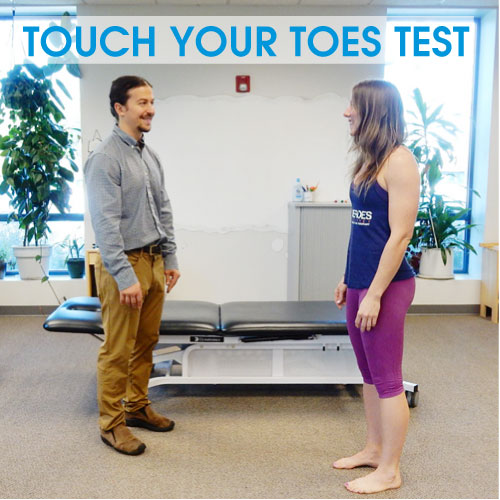
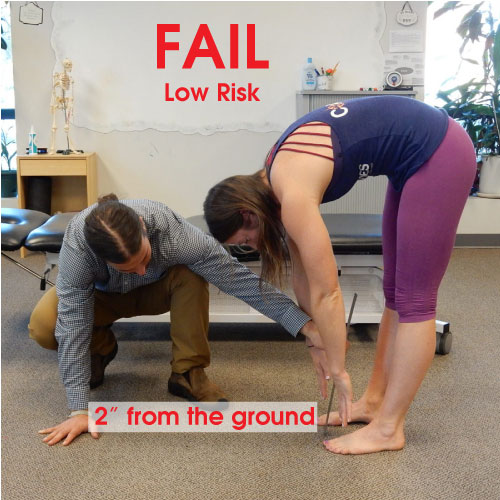
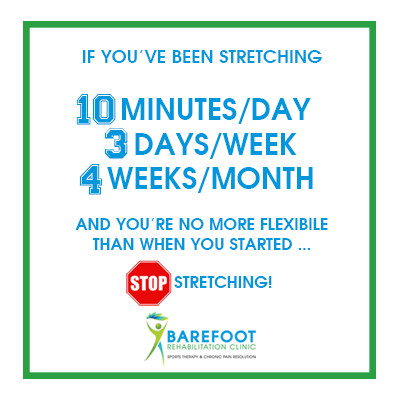
Know Your Numbers: Standards for Musculoskeletal Health, The Low Back, And The Touch Your Toes Test | Primal Docs
Posted at 22:32h, 29 December[…] Know Your Numbers: Standards for Musculoskeletal Health, The Low Back, And The Touch Your Toes Test […]
I Don't Care About Your Herniated Disc
Posted at 22:45h, 10 January[…] the amount of adhesion (aka fuzz, bubble gum, scar tissue, or glue) in your soft tissue between your muscles, ligaments, nerves, and tendons as evidenced by flexibility tests like the Touch Your Toes Test. […]
Know Your Numbers: Ankle Pain, Foot Pain, and Ankle Dorsiflexion Test
Posted at 20:00h, 15 January[…] You Need to Know: A calf stretch during the SLPF Test has a completely different physiologic cause than this test. It’s nerve in the former, […]
Know Your Numbers: The Thigh to Chest Test
Posted at 21:01h, 01 June[…] While you’re awaiting 30 days from now to reassess, you might as well get baseline measurements for your ankles and your low back. […]
Dave Brochin
Posted at 03:39h, 12 SeptemberOne of the Dragon Door kb gurus has a YouTube with a toe touch, falling short, then squeezing a block with adductors and , miracle, he can touch the floor. My point being maybe the test doesn’t actually demonstrate the flexibility, but just how well you can momentarily fool your neurological system. Thoughts?
Dr. Chris
Posted at 11:58h, 12 SeptemberHi again David, I’m smiling after reading your comment. I agree 100%, with certainty. I call this a “neurological reflex.” After the nerve is no longer activated (in a few minutes, or a few hours), usually the range of motion (and tightness) will come right back to where it was before it started. It does look like a “miracle”. A good intervention for any tightness or inflexibility LASTS PERMANENTLY. Does that make sense? If my treatment always resorts back to the same range of motion, I didn’t actually help the patient. I was just playing around with reflexes and thus, offer the patient shit healthcare.